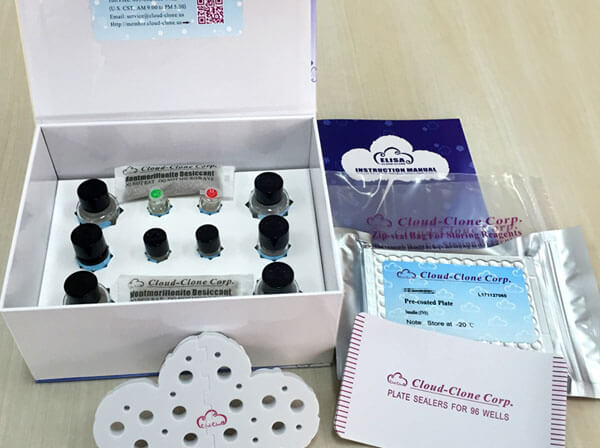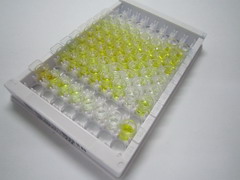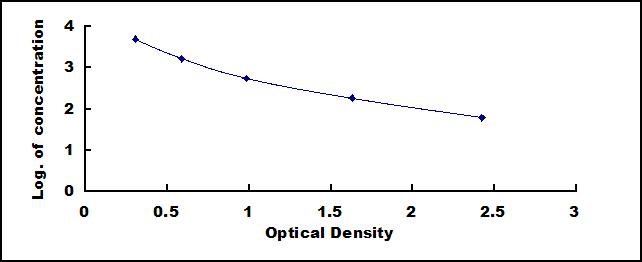ELISA Kit for Carboxymethyl Lysine (CML) 

N(6)-Carboxymethyllysine
- UOM
- FOB US$ 565.00 US$ 808.00 US$ 3,634.00 US$ 6,864.00 US$ 56,525.00
- Quantity
Overview
Properties
- Product No.CEB977Ge
- Organism SpeciesPan-species (General) Same name, Different species.
- ApplicationsEnzyme-linked immunosorbent assay for Antigen Detection.
Research use only - DownloadInstruction Manual
- CategoryMetabolic pathwayEndocrinologyCardiovascular biologyGenetic scienceNutrition metabolism
Sign into your account
Share a new citation as an author
Upload your experimental result
Review

Contact us
Please fill in the blank.
Recovery
Matrices listed below were spiked with certain level of Carboxymethyl Lysine (CML) and the recovery rates were calculated by comparing the measured value to the expected amount of Carboxymethyl Lysine (CML) in samples.
| Matrix | Recovery range (%) | Average(%) |
| serum(n=5) | 79-98 | 90 |
| EDTA plasma(n=5) | 82-93 | 87 |
| heparin plasma(n=5) | 82-104 | 89 |
Precision
Intra-assay Precision (Precision within an assay): 3 samples with low, middle and high level Carboxymethyl Lysine (CML) were tested 20 times on one plate, respectively.
Inter-assay Precision (Precision between assays): 3 samples with low, middle and high level Carboxymethyl Lysine (CML) were tested on 3 different plates, 8 replicates in each plate.
CV(%) = SD/meanX100
Intra-Assay: CV<10%
Inter-Assay: CV<12%
Linearity
The linearity of the kit was assayed by testing samples spiked with appropriate concentration of Carboxymethyl Lysine (CML) and their serial dilutions. The results were demonstrated by the percentage of calculated concentration to the expected.
| Sample | 1:2 | 1:4 | 1:8 | 1:16 |
| serum(n=5) | 83-101% | 98-105% | 87-95% | 87-94% |
| EDTA plasma(n=5) | 82-102% | 99-105% | 80-95% | 87-101% |
| heparin plasma(n=5) | 91-105% | 91-103% | 91-98% | 89-103% |
Stability
The stability of kit is determined by the loss rate of activity. The loss rate of this kit is less than 5% within the expiration date under appropriate storage condition.
To minimize extra influence on the performance, operation procedures and lab conditions, especially room temperature, air humidity, incubator temperature should be strictly controlled. It is also strongly suggested that the whole assay is performed by the same operator from the beginning to the end.
Reagents and materials provided
| Reagents | Quantity | Reagents | Quantity |
| Pre-coated, ready to use 96-well strip plate | 1 | Plate sealer for 96 wells | 4 |
| Standard | 2 | Standard Diluent | 1×20mL |
| Detection Reagent A | 1×120µL | Assay Diluent A | 1×12mL |
| Detection Reagent B | 1×120µL | Assay Diluent B | 1×12mL |
| TMB Substrate | 1×9mL | Stop Solution | 1×6mL |
| Wash Buffer (30 × concentrate) | 1×20mL | Instruction manual | 1 |
Assay procedure summary
1. Prepare all reagents, samples and standards;
2. Add 50µL standard or sample to each well.
And then add 50µL prepared Detection Reagent A immediately.
Shake and mix. Incubate 1 hour at 37°C;
3. Aspirate and wash 3 times;
4. Add 100µL prepared Detection Reagent B. Incubate 30 minutes at 37°C;
5. Aspirate and wash 5 times;
6. Add 90µL Substrate Solution. Incubate 10-20 minutes at 37°C;
7. Add 50µL Stop Solution. Read at 450 nm immediately.

Test principle
This assay employs the competitive inhibition enzyme immunoassay technique. A monoclonal antibody specific to Carboxymethyl Lysine (CML) has been pre-coated onto a microplate. A competitive inhibition reaction is launched between biotin labeled Carboxymethyl Lysine (CML) and unlabeled Carboxymethyl Lysine (CML) (Standards or samples) with the pre-coated antibody specific to Carboxymethyl Lysine (CML). After incubation the unbound conjugate is washed off. Next, avidin conjugated to Horseradish Peroxidase (HRP) is added to each microplate well and incubated. The amount of bound HRP conjugate is reverse proportional to the concentration of Carboxymethyl Lysine (CML) in the sample. After addition of the substrate solution, the intensity of color developed is reverse proportional to the concentration of Carboxymethyl Lysine (CML) in the sample.
Giveaways
Increment services
Citations
- Advanced Glycation End Products Induce Human Corneal Epithelial Cells Apoptosis through Generation of Reactive Oxygen Species and Activation of JNK and p38 MAPK PathwaysPubMed: PMC3680386
- Effects of combined lipoic acid and pyridoxine on albuminuria, advanced glycation end-products, and blood pressure in diabetic nephropathy.Pubmed: 24491880
- Advanced glycation end-products accelerate the cardiac aging process through the receptor for advanced glycation end-products/transforming growth factor-β-Smad signaling pathway in cardiac fibroblastsPubMed: 26016731
- Inhibition of Advanced Glycation Endproduct Formation by Lotus Seedpod Oligomeric Procyanidins through RAGE-MAPK Signaling and NF-κB Activation in High-Fat-Diet Rats.PubMed: 26207852
- Association of serum N Îľ-Carboxy methyl lysine with severity of diabetic retinopathyPubmed:26782022
- Hyperoside reduces albuminuria in diabetic nephropathy at the early stage through ameliorating renal damage and podocyte injury.Pubmed:27255369
- Increased levels of N(ε)- Carboxy methyl lysine (N(ε)-CML) are associated with topographic alterations in retinal pigment epithelium: A preliminary studyPubmed:27039312
- Long-term administration of advanced glycation end-product stimulates the activation of NLRP3 inflammasome and sparking the development of renal injury.pubmed:27816762
- Plasma heparanase is associated with blood glucose levels but not urinary microalbumin excretion in type 2 diabetic nephropathy at the early stage pubmed:28994624
- High intake of dietary advanced glycation end-products is associated with increased arterial stiffness and inflammation in subjects with type 2 diabetes.pubmed:28958695
- Antiglycation and antioxidant activities of mogroside extract from (Swingle) fruitsPubmed:29666541
- Elevated advanced glycation end products are associated with subfoveal ellipsoid zone disruption in diabetic macular edema34708772











